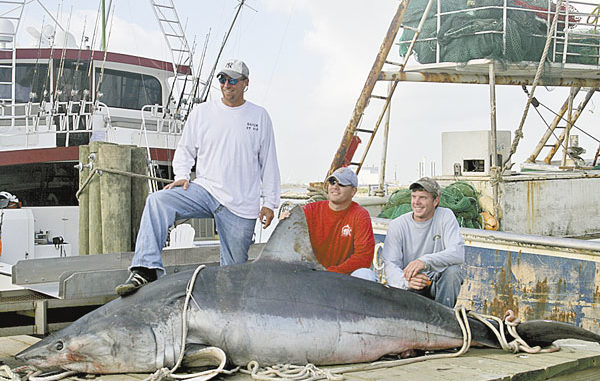
Follow this angling advice to put untapped fish in the boat this month.
Generally speaking, a shark, any kind of shark, just doesn’t make the average Louisiana saltwater angler’s heart beat faster. But this year, a 1,149-pound monster mako shark was selected by the Louisiana Outdoor Writers Association as the Fish of the Year.Caught by Bill Walters, a Texas angler, about 70 miles south of Fourchon, it shattered the old record of 765 pounds caught by Lane Foil on the Midnight Lump. It was only 72 pounds below the IGFA world record caught off Massachusetts in 2001.
The word “shark” covers a lot of ground biologically, encompassing 67 species in 14 families. They range from the repulsively flabby deepwater sevengill shark, to the positively weird Cuban dogfish with its large phosphorescent green eyes to the incredibly active and athletic mackerel sharks, the family of sharks to which this species belongs.
Mackerel sharks’ most distinctive physical feature is that both lobes of the tail fin are approximately the same size, giving it a crescent shape. In other shark families, the upper lobe is longer, sometimes much more so.
Mackerel sharks have a cone-shaped snout and are heavy-bodied in appearance. Finally, they are warm-blooded. Their ability to maintain a body temperature 10 to 18 degrees higher than that of the seawater around them allows them to be so active.
The mackerel shark family has five living species — the salmon shark, the porbeagle or mackerel shark, the great white shark, the longfin mako shark and the shortfin mako shark. The extinct megalodon shark was a member of this family. Fossilized triangular teeth from this monster up to 8 inches long have been found, projecting the fish at 49 feet long, three times the size of a great white shark.
The longfin mako shark, Isurus paucus, is an uncommon, more tropical, deepwater species that was not even recognized as a species until 1966. Its strongly elongated pectoral fins are assumed to make it less active than its short-finned cousin.
The scientific name of the shortfin mako, Isurus oxyrinchus, is descriptive of the fish. Isurus means “the same tail” referring to both lobes of tail being similar and size, and oxyrincus means “pointy snout.”
Live shortfin makos are a striking cobalt or metallic blue to bluish gray above. They are always snow white beneath, unlike their longfinned cousin, which is pigmented beneath the head. Probably only the blue shark can rival the shortfin mako in coloration.
Both species of mako sharks have distinctively long, slender smooth-edged teeth that are noticeably different than the triangular serrated teeth of other sharks. Some teeth are visible even when their mouths are closed.
Shortfin makos can be found over a huge worldwide range in all tropical and temperate oceans and seas. In the Atlantic, they are found from Nova Scotia, Canada, south through the Gulf of Mexico down to Argentina. It is an open-water species, found from the surface down to depths of 500 feet, although usually not near shore.
Shortfin makos are among the fastest of sharks, if not the fastest, and can swim long distances at 20 to 30 mph. Bursts of 46 mph have been recorded. Indeed makos, like other mackerel sharks, must swim to live. They cannot pump water over their gills, so they must use the ram-jet ventilation of constant swimming to force water over their gills.
Shortfin makos travel long distances. A female tagged off of California was recaptured 1,725 miles away. Another tagged animal moved an average of nearly 36 miles a day to swim 1,322 miles in 37 days.
Shortfin mako sharks feed mainly on fast-moving fish as well as sharks and squid. A food-habit study done off of South Africa showed that 60 percent of their diet there was other sharks and 40 percent was bony fish. Another done off the northeastern U.S. found that more than 77 percent of their diet was bluefish.
Shortfin makos are known to also prey heavily on mackerels, tunas and swordfish. Makos have been recovered with broken-off swordfish bills in their gills, heads and eyes. Swordfish are also occasionally caught bearing bite marks on their bodies from sharks.
Typically eating three percent of their body weight a day (compared to less than one percent for most other sharks), shortfin makos grow faster than most other shark species. A male needs only 4½ to 5 years to grow to maturity at 300 pounds.
Shortfin makos are ovoviviparous, meaning that females retain their eggs internally until they hatch. During the 15- to 18-month gestation period, the young sharks engage in oophagy, which means that they dine on later batches of unfertilized eggs produced by their mother. Four to 18 young are born per litter.
Shortfin mako sharks have been known to attack humans and even boats, but probably their greatest danger is a leaping hooked shark landing in a boat after one of its jumps. Shortfin makos can leap to heights of 30 feet in the air.
This leaping ability coupled with the fish’s slashing power and size makes it a desirable game fish. They will take trolled baits and lures, as well as dead and live baits fished from anchored or drifting boats.
The shortfin mako shark has excellent table qualities, and its flesh is often compared to that of swordfish.
Jerald Horst is author of four books on fish and seafood, including the acclaimed Trout Masters: How Louisiana’s Best Anglers Catch the Lunkers. His latest book, co-authored with his wife Glenda, is The Louisiana Seafood Bible: Crawfish.


